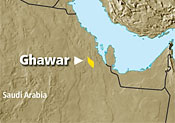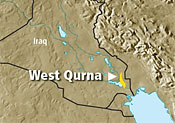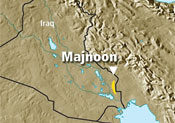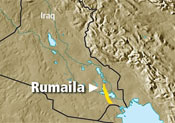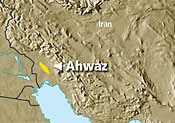| http://blog.chosun.com/stargate888/4470061 | ||||||
|
In Depth: The Top Oil Fields of the Future
1. Ghawar. Saudi Arabia. 30 Billion Barrels.
The once and future king. Ghawar is thought to have had more than 100 billion barrels of recoverable oil in place. At 160 miles long and 16 miles wide it boggles the mind of even the most experienced geologists. With something on the order of 60 billion produced over the past 60 years, you'd be excused for thinking that Ghawar was sliding into its twilight years. Yet the Saudis insist that Ghawar is still going strong, producing 4.5 million bpd from six main producing areas with the ability to do 5 million bpd if called upon.
2. West Qurna. Iraq. 21 Billion Barrels.
This month a joint venture between ExxonMobil and Royal Dutch Shell were awarded the contract to develop the 9 billion barrel first phase of the West Qurna oil field. They will aim to raise output from 300,000 bpd to 2.3 million bpd. It's tough to make the case that the two biggest oil companies from the countries that invaded Iraq in 2003 are getting a sweetheart deal. The contract calls for the government of Iraq to retain ownership of the field and the oil.
3. Majnoon. Iraq. 13 Billion Barrels.
Massive reserves in a relatively small area near the Euphrates River in southern Iraq, the field's abundance was so mind-boggling that it was named Majnoon, Arabic for "crazy." This easy oil hasn't been developed in part because of its location so close to the Iranian border. In the 1980s, during the Iran-Iraq war, managers reportedly buried the wells, concerned that they might be targeted by Iranian forces. The field produces just 50,000 bpd now but has the potential to do 1.8 million bpd.
4. Rumaila. Iraq. 17 Billion Barrels.
In November, British giant BP and China National Petroleum won the first oil contract of the post-Saddam era to redevelop Rumaila. Located on the border with Kuwait, the field is already producing 1 million bpd, half of Iraq's total production. The partners intend to spend some $15 billion to treble that to 2.85 million bpd. That output would be enough to put Rumaila in second-place worldwide after Saudi Arabia's Ghawar.
5. Khuzestan. Iran. 100 Billion Barrels?
Not just a field, Khuzestan is the province where 90% of Iran's oil is produced. It borders Iraq and is home to the Ahwaz field, thought to produce 300,000 bpd, and the Yadavaran field, which is being developed by China's Sinopec under a $70 billion deal made in 2004. Last year in the province Iran trumpeted the discovery of an 8 billion barrel field called Soussangerd. Iraq's Majnoon field is thought to extend over the border into Khuzestan territory.
Click here to see the full list of The Top 10 Oil Fields of the Future
by Christopher Helman Chances are your energy needs are going to flow from one of these fields in the future. This month Iraq will finalize contracts with the likes of ExxonMobil, Royal Dutch Shell and BP to develop some of its biggest oil fields. These giants are among the world's last remaining pockets of so-called "easy oil." They don't require ultradeep drilling or innovative production techniques, just the application of Big Oil know-how. No wonder the oil companies agreed to develop Iraq's fields without even getting an ownership stake in the fields and collecting as little as $1.15 per barrel recovered. Given the size of Iraq's undeveloped giants there are no technical reasons why within 10 years the country can't supplant both Iran and Russia to become the world's No. 2 oil producer after Saudi Arabia. No wonder Iraq holds three of the top 10 fields of the future. The world gets its daily ration of 85 million barrels of oil from more than 4,000 fields. Most of these are small, less than 20,000 barrels per day. Giants, producing more than 100,000 bpd, account for just 3%. Then there's the megafields that gush out 1 million bpd. These are the most important sources of energy in the world--fields worth fighting over. In figuring the top 10 fields of the future, we're not interested in most of the giants of yesteryear, and not necessarily even the giants of today. Just the giants of tomorrow--those fields that might not even be producing yet, but will likely be doing better than 1 million bpd a decade from now.
The once and future king of the world's oil fields, Ghawar, in Saudi Arabia, ranks first on our list. It is thought to have had more than 100 billion barrels of recoverable oil in place. At 160 miles long and 16 miles wide it confounds even the most experienced geologists. With something on the order of 60 billion produced over the past 60 years, you'd be excused for thinking that Ghawar was sliding into its twilight years. Yet the Saudis insist that Ghawar is still going strong, producing 4.5 million bpd from six main producing areas with the ability to do 5 million bpd if called upon. The secret to Ghawar's longevity is water injection. Starting in the 1960s Saudi Aramco began injecting water underneath the oil around the outer borders of the field. Today the water flood is up to millions of barrels a day, with the oil floating up to the top of the reservoir on sea of water. In conversations with Forbes in 2008 Aramco executives insisted that by continuing to treat Ghawar with kid gloves they'll be able to coax 4 million bpd out of her for many years to come. Coming in second is West Qurna, in Iraq, home to an expected 21 billion barrels of oil. This month a joint venture between ExxonMobil (XOM) and Royal Dutch Shell (RDSA) was awarded the contract to develop the 9 billion barrel first phase of the West Qurna oil field. They will aim to raise output from 300,000 bpd to 2.3 million bpd. It's tough to make the case that the two biggest oil companies from the countries that invaded Iraq in 2003 are getting a sweetheart deal. The contract calls for the government of Iraq to retain ownership of the field and the oil. Exxon and Shell, as contractors, are to be paid just $1.90 for each a barrel they produce. Third is Majnoon, also in Iraq. At 13 billion barrels, these massive reserves are in a relatively small area near the Euphrates River in southern Iraq. The field's abundance was so mind-boggling that it was named Majnoon, Arabic for "crazy." This easy oil hasn't been developed in part because of its location so close to the Iranian border. In the 1980s, during the Iran-Iraq war, managers reportedly buried the wells, concerned that they might be targeted by Iranian forces. The field produces just 50,000 bpd now, but has the potential to do 1.8 million bpd. The Rumaila field in Iraq, with 17 billion barrels, is the fourth-largest field. In November, British giant BP (BP) and China National Petroleum Corp. won the first oil contract of the post- Saddam era to redevelop Rumaila. Located on the border with Kuwait, the field is already producing 1 million bpd, half of Iraq's total production. The partners intend to spend some $15 billion to treble that to 2.85 million bpd. That output would be enough to put Rumaila in second place worldwide after Saudi Arabia's Ghawar. So what won't you see on this list? Mexico's Cantarell is nowhere to be seen. It used to be the second-biggest producer in the world, giving more than 2 million bpd; it's now in terminal decline, slipping below 400,000 bpd. Likewise Russia's Samotlor. It was the monster field of the Soviet Union, with production peaking at 3.5 million bpd in the 1970s. Today it's doing more like 350,000 bpd. No respect for China's biggest field Daging either; it still produces roughly 800,000 bpd but is in serious decline. As for Canada's heralded oil sands region--sure it's a massive resource, but easy oil it ain't. Oil sands require monstrous amounts of water and natural gas to recover and process. A barrel of oil sands oil costs roughly 20 times more to produce than one from Iraq. And environmentalists think it's dirty. Lots of oil provinces didn't quite make the cut. West Africa could see the biggest growth of all across Nigeria, Angola and Ghana--but so far no individual fields look big enough on their own. Same for Siberia, which has most of Russia's production, but from mature fields. Saudi Arabia could have been better represented. Its 750,000 bpd Shaybah field was a runner-up. Iraq too. The government didn't receive any bids to redevelop the 8 billion barrel East Baghdad field because much of it lies under residential neighborhoods. And Kirkuk, in northern Iraq, has something like 8 billion barrels remaining, but it was damaged by overproduction in the latter years of Saddam's rule and won't likely regain its peak of 700,000 bpd. But it could. | ||||||
|
| ||||||
'머물렀던 흔적들' 카테고리의 다른 글
| [스크랩] 비오는 수요일에 빨간 장미가 생각나는 과학적인 이유 (0) | 2010.01.28 |
|---|---|
| 아름다운 꽃들의 세계 - Rick Evans (0) | 2010.01.27 |
| 방랑자들의 목소리 (0) | 2010.01.25 |
| 서민 화가 박수근의 작품 세계 / 수채화 (0) | 2010.01.24 |
| Beautiful Pictures with Music (0) | 2010.01.21 |
